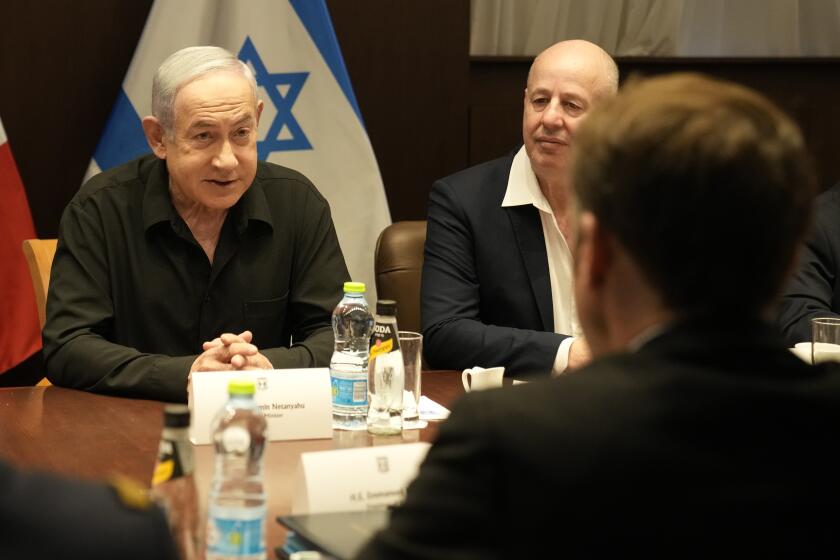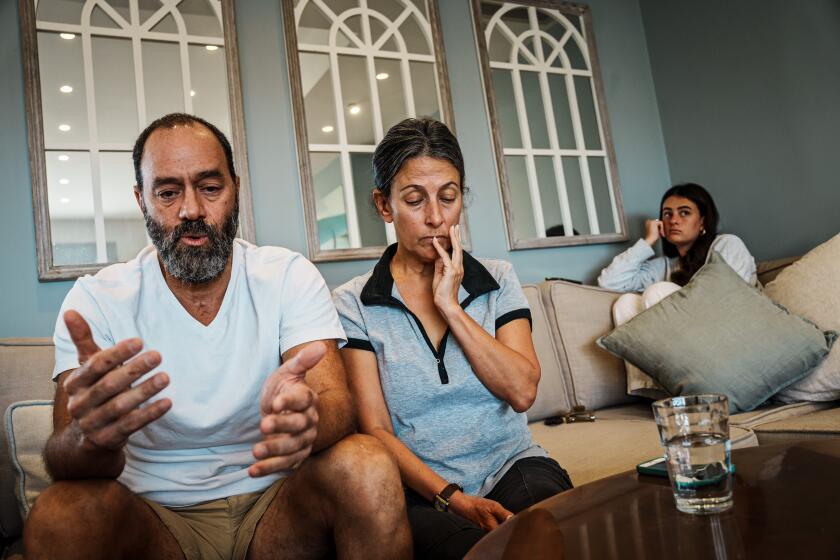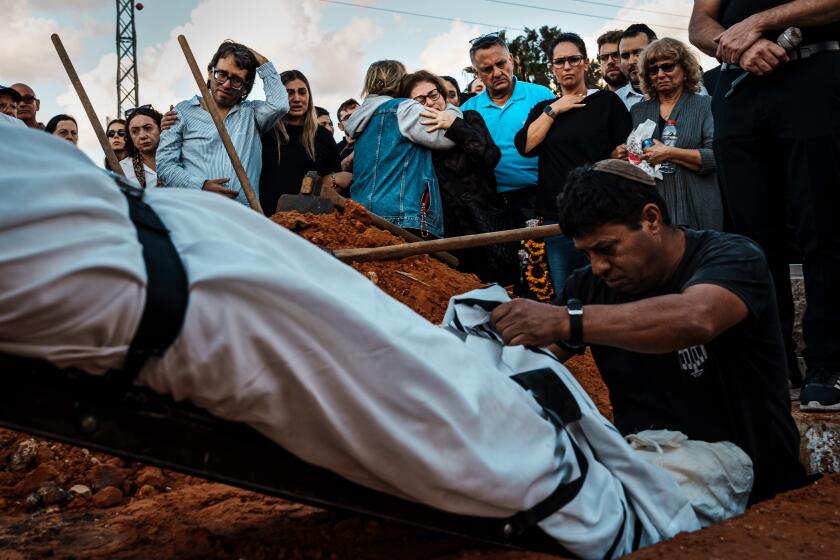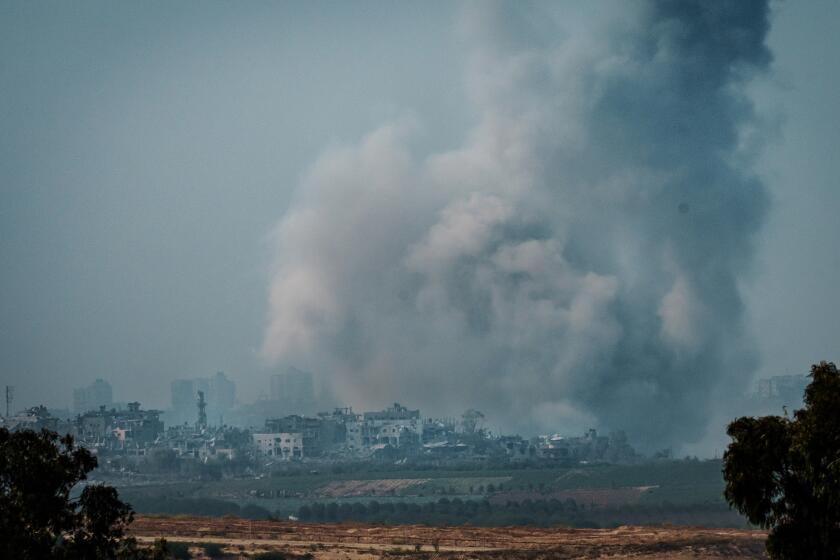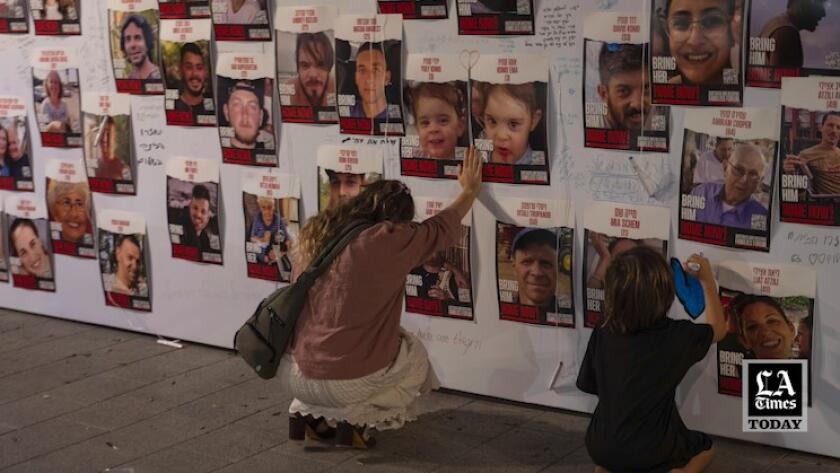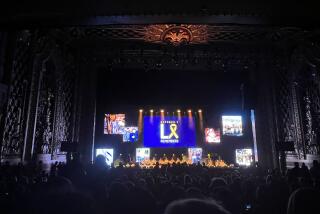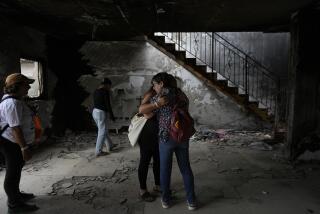A young Israeli festival-goer’s death is confirmed, shining light on families’ long ordeal
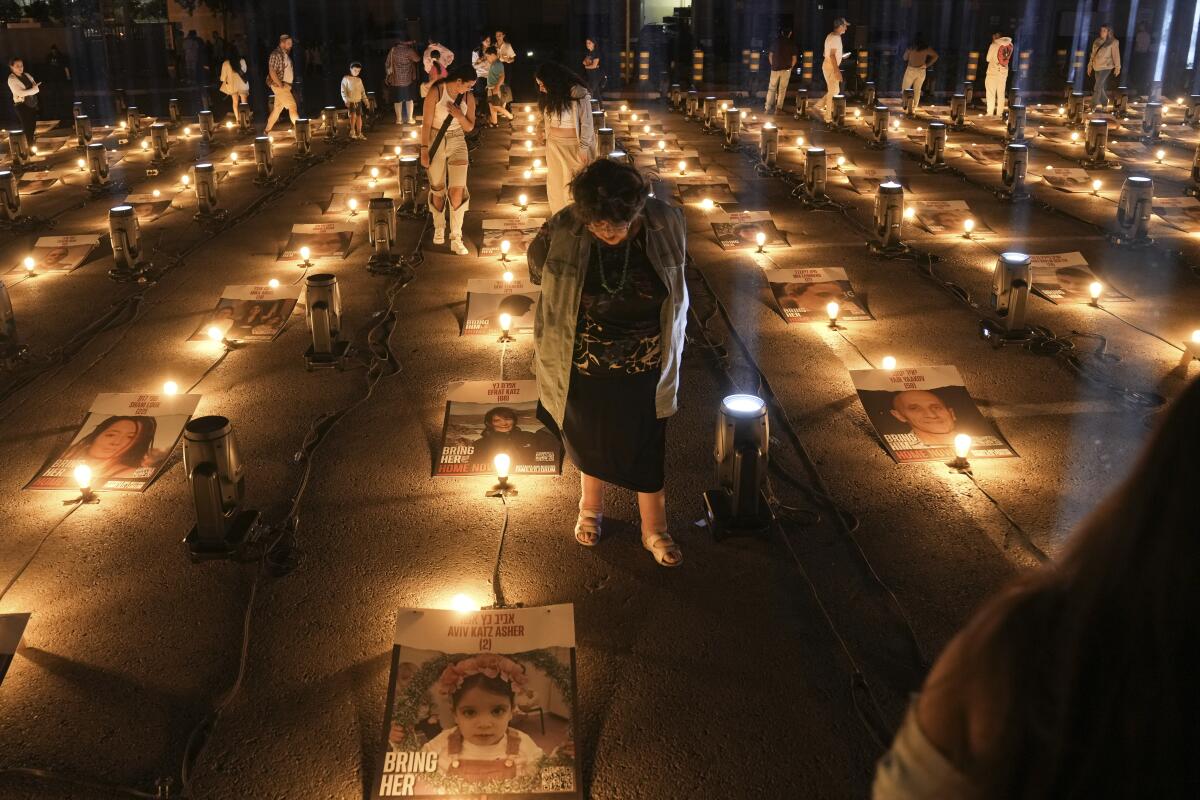
- Share via
TEL AVIV — Few who saw gruesome video footage of Shani Louk’s near-naked body being paraded through the streets of Gaza more than three weeks ago would have imagined the young German-Israeli woman might still be alive. But some friends and family had clung to that hope.
Israel’s foreign ministry on Monday confirmed the death of Louk, 22 — one of hundreds of young people, Israeli and foreign, who had flocked earlier this month to an all-night desert rave staged just three miles from the border fence with Gaza.
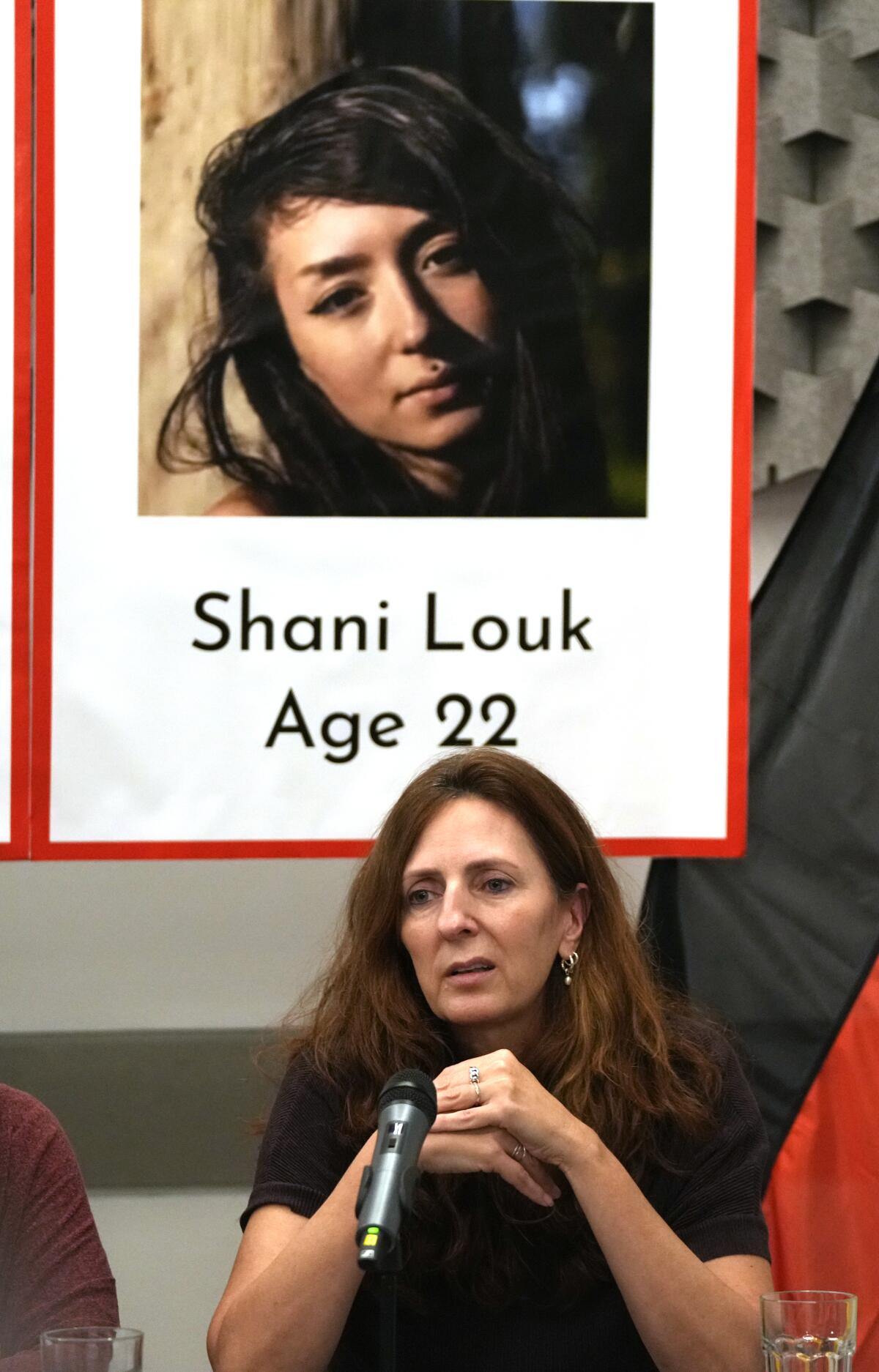
When Hamas militants surged across the frontier before dawn on Oct. 7, one of their first targets was the sprawling encampment where the huge open-air party was taking place. There was festival security, but it was set up mainly for crowd control and dealing with medical emergencies, not to counter a lethal and well-organized military-style assault.
In normal times in Israel, the music festival massacre, which taken alone would represent the worst mass killing of civilians since the state’s creation 75 years ago, would have dominated national discourse for weeks. But the estimated 260 deaths were only one element of the day’s larger horror: the slaughter of 1,400 people, four-fifths of them civilians.
The fatality count is still imprecise because the long process of body identification is still going on, with funerals still occurring daily across the country. Some families embark upon the weeklong Jewish mourning ritual of sitting shiva only after receiving formal forensic proof of a death that took place weeks ago.
The festival attack, horrifying as it was for Israelis, was swiftly subsumed by a crush of fast-moving events: the declaration of war with Hamas, the ongoing crisis over the militants’ seizure of more than 230 hostages, and Israel’s intense round-the-clock bombing of wide swaths of the Gaza Strip, a sealed-off territory inhabited by more than 2 million Palestinians.
Israel-Hamas war: In a national vigil of sorts, Israelis hope for the return of more than 220 people seized by militants and believed held in Gaza.
Desperate humanitarian conditions inside the enclave have set off widespread calls for a pause in the Israeli bombardment and ground operation, which Israel says is meant to eradicate Hamas, kill its leaders and end its governance of Gaza. The death toll in the Gaza Strip has passed 8,300, according to Palestinian health officials, and this conflict is already deadlier than Israel’s four previous wars with Hamas combined.
For weeks now, grisly accounts of the festival attack in Israel have circulated, with multiple survivors relating their ordeals on social media and in interviews. Family members recounted receiving desperate early-morning calls and texts from sons and daughters at the rave as the deadly attack and hostage-taking rampage was unfolding.
In their telling, attackers on motorbikes and in trucks descended on the encampment as a rocket attack on the area was underway, with initial volleys of gunshots drowned out by the sound of projectiles roaring overhead. The assailants cut off routes by which many tried to flee by car and pursued terrified attendees on foot into surrounding fields and brushland, where many recounted hiding for hours.
Israelis fault Prime Minister Benjamin Netanyahu for security failures that set the stage for war. Few see a path to leadership change amid the crisis.
Festival-goers who managed to escape or conceal themselves described seeing friends and strangers cut down by gunfire or seized and dragged away by militants. In one of the day’s most striking images, a brief video clip showed scores of young people fleeing across the broad vista of an open field.
Many sought safety in nearby small communities, but their pursuers followed, tossing grenades into public bomb shelters where some huddled, survivors recounted. The parents of 23-year-old California-born Hersh Goldberg-Polin, who spoke to the Los Angeles Times five days after the attack, said his first text to them that morning said, “I love you.” The second one said, “I’m sorry.”
“I immediately took that to mean he knew he was in trouble, that it would cause us a lot of pain, and he was sorry,” said his mother, Rachel Goldberg.
California native Hersh Goldberg-Polin, 23, hasn’t been seen by family since before Hamas’ attack on Israel. They’re determined to find him and bring him home.
Witnesses who were with Goldberg-Polin at the time told them their son was seriously injured in the attack, with part of his arm blown off by a grenade, and video surfaced last week of him being loaded into a vehicle at gunpoint upon his capture. But the parents have heard nothing more.
In addition to the festival-goers, other captives taken into Gaza were seized from nearby small communities, where the attackers caught dozens of families by surprise at home, killing, mutilating and torturing many victims, according to witnesses, rescue officials and body camera video taken by the assailants.
The dead and abducted ranged in age from infants to the very elderly, and included scores of children.
Louk was described by friends and family as a free-spirited young woman who loved raves just like this one was intended to be: communal gatherings in natural settings, with hypnotic trance music that throbs through the night. Her social media posts from shortly before the attack showed her striking poses with friends and dancing exuberantly.
Israel-Hamas war: In Israel, a quest to identify unrecognizable bodies. In Gaza, bodies are piled and some stored in ice cream trucks as power fails.
The footage of Louk’s body being displayed in the streets of Gaza as a seeming trophy, spat upon by at least one onlooker, was one of the first atrocity clips to circulate widely in the wake of the festival massacre. Now, far more video of the attack and its aftermath is in online circulation, some of it taken by body cameras.
It took many Israelis some days to grasp the full ferocity of the Hamas-led attack, as forensic doctors issued grimly clinical reports detailing victims’ fatal injuries: scores of close-range shootings, one man’s neck hacked through with a garden hoe, burns and smoke inhalation suffered after homes were set ablaze while people sheltered in safe rooms, many bodies with hands bound, bearing signs of torture.

In the video shot that day in Gaza, Louk’s limp body lay facedown in the back of a truck, surrounded by armed men. Her bare legs, adorned with distinctive diagonal tattoos, were splayed at unnatural angles. Her long blond-tipped dreadlocks were tangled at the base of her skull, appearing soaked with blood.
Despite there being no evident sign of life at the time, her mother, Ricarda Louk, said in a public appeal for information after the attack that video had shown her daughter “unconscious” in a vehicle being driven through Gaza.
Assuming some possibility of her survival, Louk’s friends and relatives took part in what has become a highly visible campaign by hostage families demanding that the Israeli government and military planners make rescue of the captives the top priority as Israeli troops push deeper into Gaza.
Israel-Hamas war: With restored communications came fresh images and videos of Gaza devastation, and news of loved ones who were hurt or killed.
On Monday, though, Ricarda Louk told the German broadcaster RTL that she now assumed her daughter had been dead since the day of the attack, and may have been shot in the head in the course of it.
Before the confirmation of Louk’s death by Israeli officials, Hebrew-language media in Israel said Israeli rescuers — who include ultra-Orthodox volunteers who conduct painstaking searches for scattered bits of human remains in order to meet traditional Jewish burial requirements — found a piece of bone at the festival scene whose DNA matched that of Louk.
The fragment’s separation from bone structure at the base of the skull ruled out survival, the reports cited rescuers as saying. Israel’s main forensic institute has said it has begun declaring some victims dead based on evidence, from recovered body parts, of what would have been fatal injuries.
Family and friends, meanwhile, surfaced dozens of other images of Louk in happier times, smiling on a palm-fringed beach, giggling with friends, or with a majestic mountain backdrop.
Louk’s father, Nissim Louk, told Israel’s Channel 13 that despite sorrow over her death, the family is at least spared the fate of many other hostage families, who fear their loved ones will be killed during stepped-up Israeli ground operations or in the waves of airstrikes that have devastated the seaside territory.
“She isn’t lying in some tunnel under Gaza, where every minute we are firing at them, and all the earth is shaking, and there is dust, and it’s impossible to breathe,” he said. “We know she is dead.”
- Share via
Watch L.A. Times Today at 7 p.m. on Spectrum News 1 on Channel 1 or live stream on the Spectrum News App. Palos Verdes Peninsula and Orange County viewers can watch on Cox Systems on channel 99.
More to Read
Sign up for Essential California
The most important California stories and recommendations in your inbox every morning.
You may occasionally receive promotional content from the Los Angeles Times.

